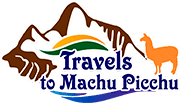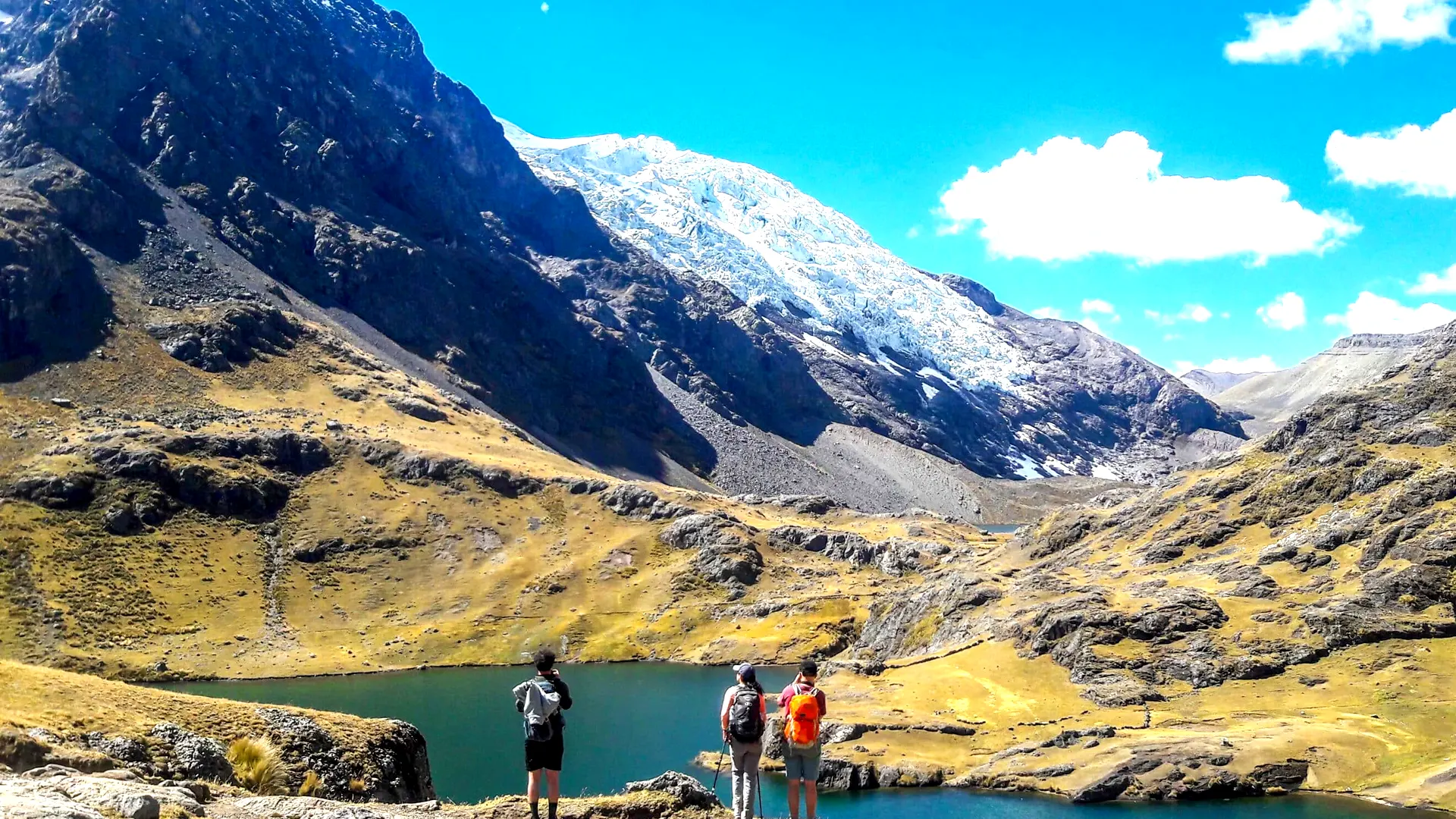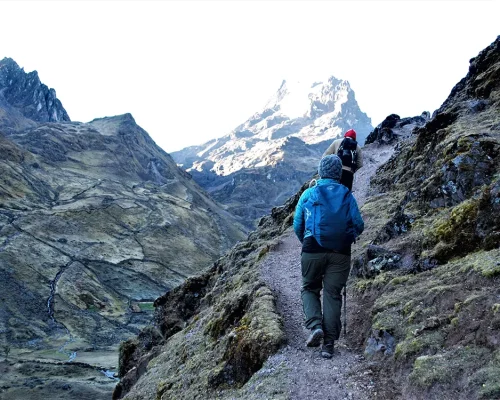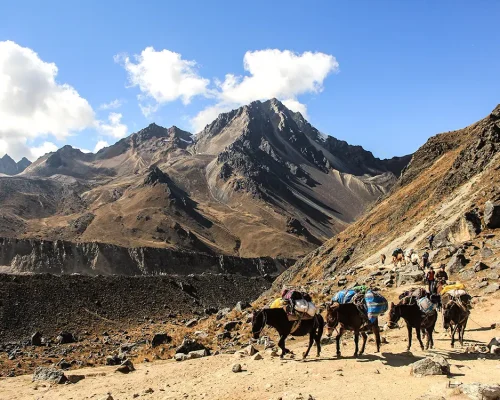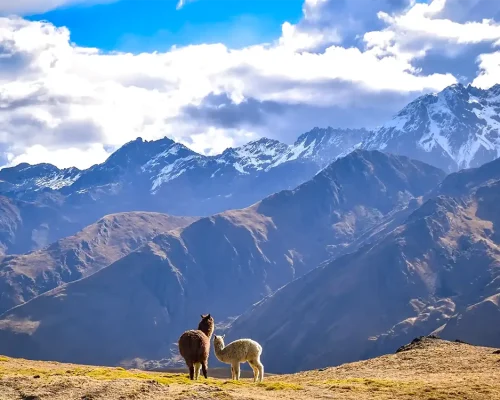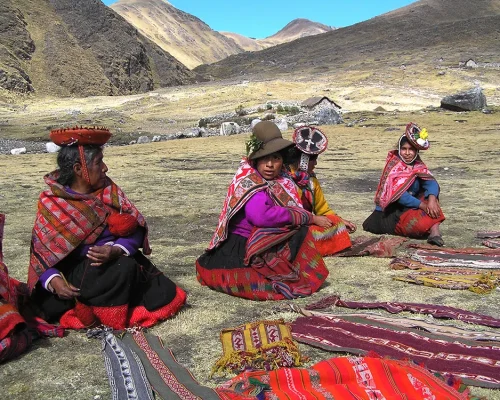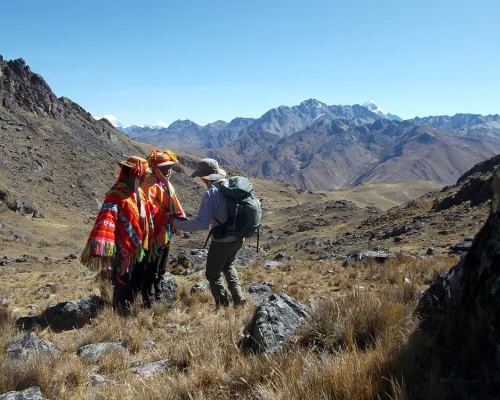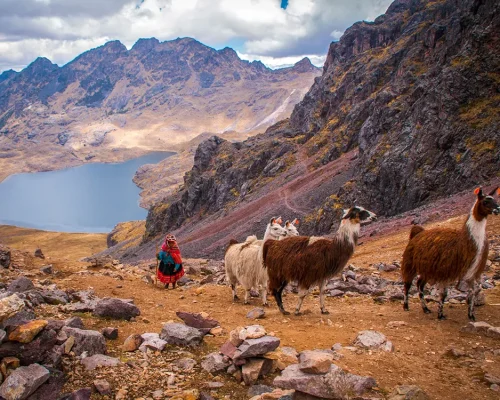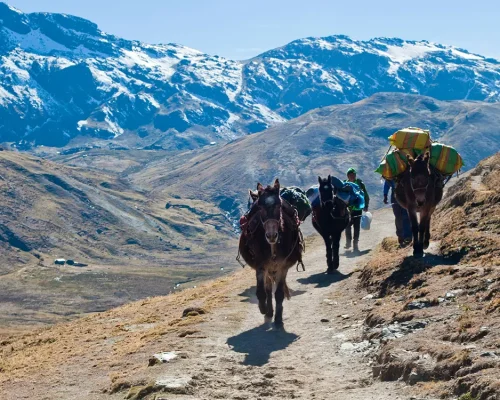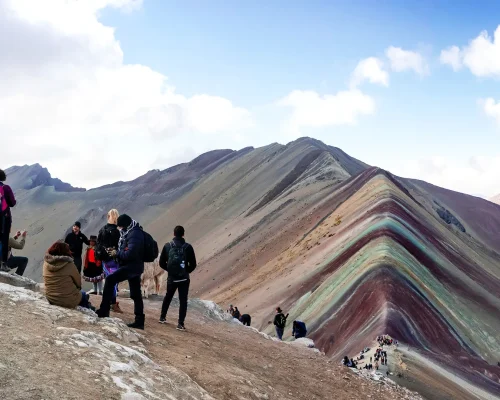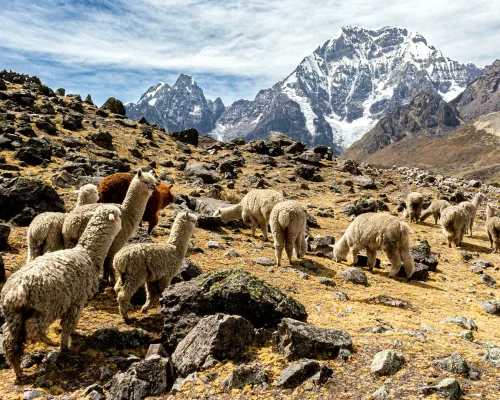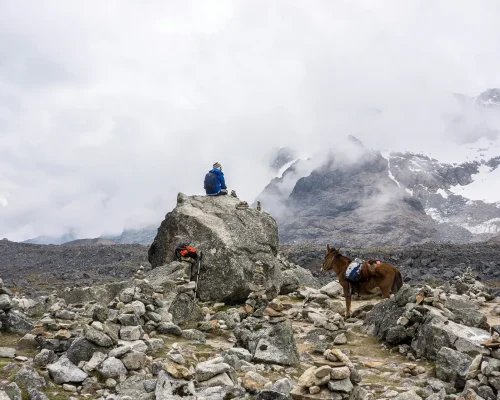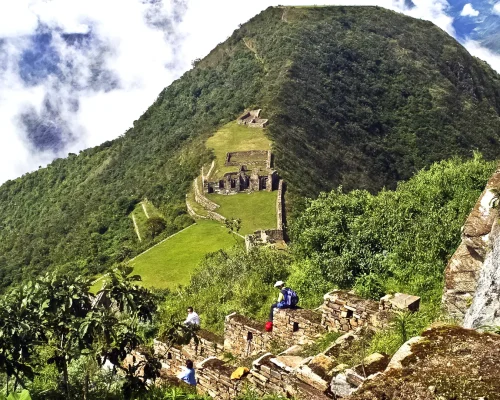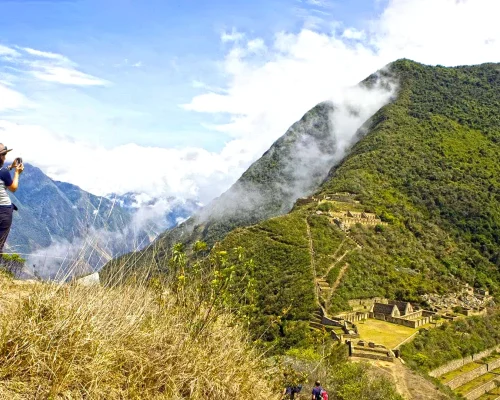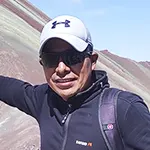Overview
Embark on an unforgettable adventure through the heart of Peru, where ancient Inca traditions and stunning natural landscapes converge. This immersive journey takes you from the vibrant city of Cusco into the serene Andean highlands, offering a unique blend of cultural encounters, breathtaking scenery, and authentic local experiences.
Over the course of four days, you’ll traverse diverse terrains—from invigorating treks among volcanic hot springs and lush valleys to explorations of charming villages steeped in history. With expert guidance, comfortable accommodations, and engaging activities, this expedition promises a memorable exploration of Peru’s rich heritage and natural beauty.
Day-by-Day Itinerary
- Day 1: Cusco – Famous Thermal Baths – Kiswarani Waterfall Campsite
- Day 2: Quiswarani – Condor Pass – Cancha Cancha Village
- Day 3: Cancha Cancha – Huaran – Maras Salt Mine – Ollantaytambo – Aguas Calientes
- Day 4: Machu Picchu – Ollantaytambo – Cusco
Itinerary
Day 1: Cusco – Famous Thermal Baths – Kiswarani Waterfall Campsite
We’ll pick you up from your hotel at 5 a.m. to begin the Lares Trek. Pickup is available from any hotel, condo, or apartment in Cusco, Urubamba, Huaran, or Pisaq. After a scenic three-hour drive through the Sacred Valley and into the high Andes, we arrive at the Lares Hot Springs. Here you’ll enjoy a hearty breakfast with panoramic mountain views, then soak in a series of volcanic pools—temperatures range from bracingly cool to soothingly warm—renowned for their therapeutic minerals that soothe muscles, ease headaches, and relieve stress.
After relaxing in the pools, we drive 20 minutes to the trailhead at Punta Carretera (3,300 m / 10,827 ft), where you’ll meet your horses, riders, and hand over your duffel bags. Your expedition begins with a two-hour gradual uphill hike to the first village of Kiswarani, known as the “potato valley” for its dozens of organic potato varieties. Along the way, your guide will point out indigenous medicinal plants used by local communities. At lunchtime, savor a homemade meal prepared by our trekking chef.
Following lunch, our llameros perform a traditional llama blessing ceremony, explaining why llamas were sacred to the Incas and vital to their economy. Although once plentiful, llamas are now disappearing for various reasons. By involving them in our trek, we help sustain both the animals and the communities that care for them. Llamas are gentle and friendly—just watch out, they might give you a friendly nuzzle or “kiss”!
You’ll then have time to explore the village and visit local homes to learn about Andean lifestyles and ancient traditions. If time allows, we’ll visit the schoolhouse where students still speak Quechua. Feel free to bring toys, notebooks, or school supplies to share, and perhaps teach a few English words.
Next, enjoy another two-hour gradual climb to our campsite beside the waterfall. There, our trekking staff will have your tents set up and ready. As dusk settles, sip hot drinks under a blanket of stars before a delicious dinner cooked on-site. If you’d like, stay up longer to gaze at the Milky Way; otherwise, retreat to your cozy tent for a peaceful night.
Day 2: Kiswarani – Pachacute (Condor Pass) – Cancha Cancha Village
Wake around 5 a.m. to hot drinks and spectacular views of the colorful lake at Kiswarani. After breakfast and packing your gear, refill water bottles and grab snacks for the trail. You’ll then begin a three- to four-hour zigzag climb to Pachacute Pass (aka Condor Pass) at 4,680 m / 15,354 ft. An emergency horse is available if you need a break. At the summit, above the clouds, enjoy a 360° panorama—including the towering peak of Pitusiray (5,700 m / 18,700 ft)—alongside a hot beverage service carried by your porters. Don’t forget your camera for this unforgettable vista.
After soaking in the view, descend for one hour to El Mirador (Vista Point) for lunch, with llamas grazing nearby. Then tackle a three-hour downhill trek through glacial streams, meadows, and alongside alpaca herds until you reach Cancha Cancha (3,750 m / 12,303 ft). This remote village has no electricity or cars, and 85 % of its homes retain ancient Inca stone foundations and grass-thatched roofs. While your porters set up camp, visit with local children—your donations of food, notebooks, or school supplies support both their education and health. We invite travelers to share in this community support. Afterwards, your guide will escort you to a local family’s house, where you’ll learn about traditional llama- and alpaca-wool weaving and daily life in this Quechua-speaking village. The evening concludes with hot drinks and a hearty dinner.
Day 3: Cancha Cancha – Huaran – Maras Salt Mines – Ollantaytambo – Aguas Calientes
Your porters will wake you with a hot drink. After packing and breakfast, spend a little time visiting the village and its elementary school, where Quechua is still taught. Then embark on the final downhill leg: approximately four hours of walking past grazing llamas and alpacas, alongside fields of potatoes, fava beans, and other traditional Andean crops farmed with ancient tools.
As you descend into the Sacred Valley, notice the micro-climate shift with fields of corn, quinoa, kiwi, peaches, avocados, and more. At Huaran (2,700 m / 8,858 ft), bid farewell to your horses, riders, chef, and porters, then board our van for a short ride to the Maras Salt Mines. At 11,000 ft, over 3,000 pre-Inca salt pans cascade down the hillside, fed by a mineral-rich spring—some pans even yield pink salt. Local families manage individual pans; a small shop on-site lets you purchase these healing salts.
Next, continue by van for approximately 45 minutes to Ollantaytambo, the only living Inca town with intact water channels, terraces, and stone streets. Your guide will lead you through its historic sites before dinner at a local restaurant. Finally, board the evening train (around 7 p.m., subject to availability) to Aguas Calientes. Upon arrival, check in to your hotel and unwind.
Day 4: Machu Picchu – Ollantaytambo – Cusco
Rise before dawn to catch one of the first buses (around 5:30 a.m.) for the 30-minute ride up to Machu Picchu. Watch the sunrise illuminate the ruins, then enjoy a two-hour guided tour of this UNESCO wonder. Afterward, you’ll have time to explore on your own or hike Huayna Picchu (requires a separate ticket, $75 per person).
In the afternoon, board the train back to Ollantaytambo, then travel by bus to Cusco for a hotel drop-off.
Note:
- To extend your stay in Aguas Calientes, please let us know in advance so we can adjust train tickets and arrange lodging.
- Large backpacks are not permitted inside Machu Picchu; only day packs may be carried.
- Trekking poles are prohibited at the Machu Picchu entrance.
- Snacks and water are allowed, provided they remain inside your backpack.
Inclusions
Included
- Briefing
- Professional Guides
- Porters & Horsemen
- Hotel
- Transportation
- Equipment
- Food
- Water
- First Aid
- Extras
- Emergency Horse
Not Included
- Sleeping Bag: $20
- Inflatable Air Mattress: $15
- Walking Sticks (Pair): $15
Before You Go
Data about Peru
Peru is a country of great cultural and geographic diversity, located on the western coast of South America. The official language is Spanish, spoken by the majority of the population.
Peru’s official currency is the sol (PEN), which is accepted throughout the country. Additionally, there are many currency exchange houses in the main cities and tourist areas, where travelers can exchange currencies such as the U.S. dollar, the euro, the Japanese yen, among others.
Peru is world-renowned for its rich cultural heritage, spanning from ancient Andean civilizations like the Incas to the Spanish influence that left its mark on the country’s architecture, cuisine, and traditions. Its economy is one of the most dynamic in Latin America, and Peruvian fashion, influenced by its textile traditions, has gained international recognition, especially for its alpaca and innovative designs using natural and sustainable materials.
The climate in Peru varies greatly by region: the coast has a desert climate, the Andean areas are cold, while the Amazon rainforest enjoys a warm and humid climate year-round. Each region has its own charm and is an invitation to explore not only the landscapes but also the cuisine, history, and traditions that make this country a unique destination.
Arriving in Cusco
The Cusco airport is exclusively equipped for domestic flights. Therefore, all international travelers must land in Lima and go through Customs. Although your flight to Cusco may be operated by the same airline and on the same day, you will need to collect your luggage in Lima and recheck it for the flight to Cusco.
Flying is the quickest and most comfortable option to reach Cusco, with several airlines operating this route. While LAN is usually the most expensive, it offers many alternatives and schedules to fit your planning.
Weather in Cusco
The weather in Cusco is primarily temperate and dry, with a rainy season from November to March. During the dry season, from April to October, daytime temperatures are more pleasant, but nights can be cold due to the altitude. Daytime temperatures typically range between 15°C and 20°C, while nighttime temperatures can drop to 0°C or below.
Altitude
When booking a trip to Cusco, it is natural to have concerns about altitude sickness. Cusco’s altitude means that the air contains less oxygen, which forces your body to work harder to obtain the necessary oxygen.
It is recommended that you spend at least two days in Cusco before starting any treks in the Andes to allow your body to acclimate. Cusco is a fascinating city, full of activities, so you won’t be bored during your acclimatization period.
Altitude sickness can initially present with symptoms similar to those of a cold or hangover. Symptoms include headaches, fatigue, loss of appetite, nausea, dizziness, sleep problems, and difficulty breathing during exercise. If symptoms worsen, it is important to contact our office so that we can assist you and arrange for a medical consultation.
Generally, the symptoms are mild, so it is recommended to take things slowly to allow your body to adjust. Stay well hydrated by drinking water or coca tea, which has been used for centuries to prevent the effects of altitude sickness. Coca leaves contain alkaloids that help oxygen circulate in the blood. Avoid excessive consumption of alcohol and coffee, as they dehydrate the body. It is also important to avoid smoking and taking sleeping pills, as these hinder oxygen absorption.
Remember that the trek to Machu Picchu is not a race. Even the fittest individuals can experience altitude sickness if they rush too much. Go slowly and allow your body to adjust to the altitude.
Your doctor may recommend medications such as acetazolamide to prevent altitude sickness, which you should begin taking two days before reaching high altitude.
Group Tours
Group tours may include people with varying hiking abilities and ages. When joining one of these tours, be prepared for the group’s pace to vary, as some participants may move faster or slower than you. Everyone can walk at their own pace, and the guide will work to ensure that everyone enjoys the experience. The groups may request some modifications to the itinerary, and the guide will make the best decisions to ensure everyone’s comfort.
Strikes and Protests
Unfortunately, strikes are common in Peru and can disrupt tour itineraries. Protests may block roads or halt trains. In the event that these issues arise, we will ensure that your itinerary continues as planned, even if this means departing earlier than expected. If it becomes necessary to cancel any tour, our operations team will contact you to coordinate the best possible solutions. The safety of our clients is always our priority.
Lost Items
You are responsible for your belongings throughout the journey. We recommend that you pay attention to where you leave your items and make sure to collect everything from our vans, camps, or restaurants. Do not leave your belongings unattended, as it is possible that other travelers may pick them up without knowing who they belong to.
Travel Insurance
Travel insurance is an affordable and highly recommended option. Although trips are planned months in advance, there is always the possibility of unforeseen events.
Adventure travel carries a higher risk, so having adequate insurance will protect your investment. If you wish, we can help you contact an insurance agent who can advise you on the proper coverage.
First Aid
Every guide from Travels to Machu Picchu has been trained in first aid by medical professionals. We conduct annual training sessions to stay updated and prepared for any emergency. During the tour, each guide carries a first aid kit with basic medications, such as those for traveler’s diarrhea, as well as oxygen.
If you ever feel that you cannot continue the trek, our guides will know the safest and quickest way to get you to a place where you can receive medical attention. We will never leave you alone; there will always be a team member who will accompany you until you are in the hands of a doctor. If necessary, we will ensure that you can visit Machu Picchu at a later time and rejoin your group.
Environmental Impact
At Travels to Machu Picchu, we are committed to respecting the environment. We use biodegradable soap and take care of transporting all our trash back to Cusco. Our porters are trained to take care of the trails and collect any waste they may find from other groups. Additionally, we use eco-friendly portable toilets, which allow us to pack up waste and leave no trace in the natural surroundings. We believe in the importance of practicing responsible and sustainable tourism.
Packing List
Recommendations
- Sturdy Hiking Boots: Waterproof, broken-in boots with ankle support to handle rocky trails and river crossings.
- Rain Jacket or Poncho: Lightweight, breathable outer layer to keep you dry during mountain showers.
- Moisture-Wicking Base Layers: Shirts and pants that pull sweat away from your skin to keep you comfortable on long hikes.
- Insulating Fleece or Down Jacket: Warm mid-layer for chilly mornings and evenings at high altitudes.
- Sun Hat & Sunglasses: Wide-brimmed hat and UV-blocking sunglasses to protect against strong mountain sun.
- Sunscreen & Lip Balm: Broad-spectrum SPF 50+ lotion and protective lip balm to prevent sunburn and chapping.
- Swimsuit: For a relaxing soak in the Lares Hot Springs before or after your trek.
- Durable Daypack with Rain Cover: 20–30 L pack to carry water, snacks, camera, and extra layers safely.
- Reusable Water Bottle or Hydration Bladder: Stay hydrated by refilling at clean water sources along the route.
- High-Energy Snacks: Granola bars, trail mix, and energy gels to keep your strength up between meals.
- Headlamp or Flashlight: Essential for early starts, campsite activities, and nighttime bathroom trips.
- Personal First Aid Kit: Include blister care, pain relievers, altitude sickness tablets, and any prescription medications.
- Portable Power Bank: Keep your phone and camera charged for photos and emergency communication.
- Quick-Dry Towel: Compact microfiber towel for drying off after the hot springs or morning dew.
- Insect Repellent: To ward off mosquitoes and other biting insects during warmer valley stretches.
Price
Join us on this unforgettable 4-day adventure along Lares for USD 600 per person. This price includes everything you need for a seamless and memorable experience: transportation, professional guides, permits, food, and more.
Please note that this tour requires a minimum of two participants. Gather your friends or family and embark on this incredible journey together!
Enquire Now
Thank you for considering Travels to Machu Picchu for your next adventure in Peru. To provide you with a tailored experience, we invite you to fill out our short form. One of our travel advisors will provide you with all the information you need to enjoy an unforgettable journey.
Your Privacy is Our Priority
At Travels to Machu Picchu, we protect your personal information. We do not share, sell, or disclose your data to third parties under any circumstances.
